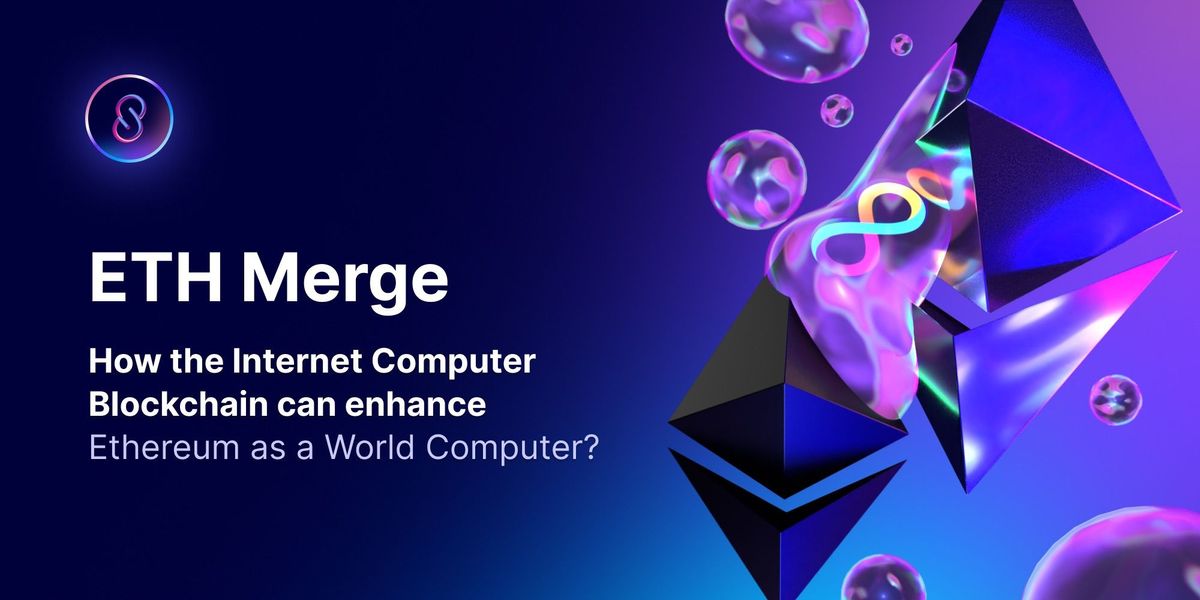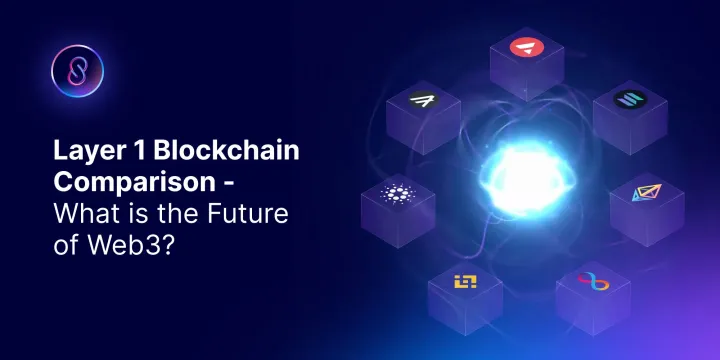How the Internet Computer Blockchain can Enhance Ethereum as a World Computer
The Internet Computer (IC) is a public blockchain that works differently from other blockchain networks with a different architectural mechanism that uses novel Chain Key cryptography and introduces new capabilities and functionalities that are open-sourced to the entire decentralized ecosystem.

The inspiration that led to the genesis of the Internet Computer project by Dominic Williams is largely attributed to Ethereum’s blockchain network and community. This was done for reasons of designing a “world computer” that will replace conventional IT and play the role of transitioning other blockchain networks into becoming fully decentralized Web3.
Since the inception of blockchain technology in 2008, many institutions have tried to create and develop a standard blockchain ecosystem that will not only solve scalability issues, but also address real-world challenges. Ethereum was the first blockchain to host Turing-complete smart contracts, which are secure pieces of code that process and store data on the blockchain.
Years later in 2014, it was realized that blockchains could act like computers, and a concept called the "World Computer" was proposed.
Shortly after, Ethereum (ETH) made its first release and genesis block on July 30th, 2015, co-authored by Vitalik Buterin and Gavin Wood, it was initially a blockchain network that was intended to be a World Computer, but the concept became inconspicuous over time as Ethereum’s design path meant that this was really beyond the scope of a real-world computer blockchain, as it would need to host most of the world's computations and data on-chain.
Dominic Williams (a close watcher and supporter of Ethereum at the time) later founded the DFINITY Foundation in Switzerland in late 2016 after receiving support from a Palo Alto incubator, String Labs.
On May 10, 2021, the Internet Computer blockchain, the first real realization of a world computer vision, finally underwent network genesis.
The Internet Computer (IC) is a public blockchain that works differently from other blockchain networks with a different architectural mechanism that uses novel Chain Key cryptography and introduces new capabilities and functionalities that are open-sourced to the entire decentralized ecosystem. The architecture of the network is directed towards the idea and design philosophy of the internet and is created by independent data centers around the world running a large number of special “node computers” that have standardized hardware.
These node computers have computing power that is combined with an advanced blockchain protocol called ICP (Internet Computer Protocol) that creates a continuously evolving environment via an upgrade of smart contracts that are fast and efficient, called “canister smart contracts” or simply “canisters.”
Ethereum, being the first blockchain to host secure pieces of code called “smart contracts” that process and store data on the blockchain, recently switched to a Proof-of-Stake (PoS) consensus mechanism on September 15, 2022, which does not really contribute any changes to its smart contract technology, but is a step towards a more secure and less power consuming blockchain.
This is now better at implementing new scaling solutions compared to the previous Proof-of-Work (PoW) architecture, which will currently allow anyone with ETH tokens to run a network node, maximizing the anonymity of participants and fighting government censorship and centralization. This is a similar technology present in the Internet Computer blockchain today.
How the Internet Computer acts as a world computer and enhances Ethereum
In contrast to other blockchains, the Internet Computer uses Chain Key cryptography for its architecture as stated earlier, which supports many unique capabilities that allow it to play the role of a world computer. It hosts canister smart contracts, which are capable of delivering interactive web experiences to users directly through HTTP requests.
This was part of the plans of the Mist Browser (from 2015 to March 2019) that was intended to be an integral part of the Ethereum network's dApps (decentralized applications) ecosystem, being the first graphical user interface that would grant users access to the blockchain at a time when it was only accessible via the command line.
Its developers had in mind to create an environment to develop and run various Ethereum applications and projects, but unfortunately, the technical requirements of a fully decentralized dApp browser system were too far from what the technology could allow. As a result, the Mist Browser project was later abandoned.
The Mist browser was an Ethereum interface intended to allow users to access the various dApps similar to how Chrome, Firefox, or Internet Explorer allow users to access websites but on the Ethereum network. It was also known as the Ethereum dApp Browser.
The browser was prone to attacks and data leaks over time due to an inability to frequently keep up with Chromium vulnerabilities that needed crucial security patches, which led to the software being withdrawn from circulation in March 2019.
The Internet Computer took advantage of this to reinvent the Internet, to create a world computer that will ultimately replace conventional IT, house all of humanity's systems and services, and enable a fully on-chain Web3 environment.
This is a completely new form of blockchain technology thanks to novel cryptography and mathematics. It does not require indefinite storage of old transaction blocks, does not require local nodes, and can scale its capacity to host computers much more efficiently than other blockchain systems.
On the Internet Computer, developers can build almost any online system or service desired just by writing canister smart contract code. Canisters are smart contracts with breakthrough levels of efficiency, have the speed to process HTTP requests and serve interactive web experiences directly to end users, and can be composed to build almost any system or service. This is why canisters are known as “interoperable computing units designed for internet-scale services.”
Some key design features of canisters include:
- General purpose usage
- Tamperproof capability
- Autonomous nature
This means that canisters are unstoppable — they can be used to develop virtually anything, and they are also tamperproof, which means their code cannot be changed. Furthermore, they can be made to run autonomously if required and can process tokens.

In terms of enhancing Ethereum…
It is apparent that after the Ethereum integration is complete, the two networks will have a mutual and direct interoperability relationship.
Canister smart contracts have paved the way to allow systems and applications to have the ability to execute custom code and be programmed to execute virtually any command, things that are not possible on the Ethereum network today.
For example, while Ethereum requires users to send a certain amount of ETH with each transaction to compensate node providers as rewards that fuel the computation resulting from invoking smart contract code, on the Internet Computer, canister smart contracts are pre-loaded with cycles tokens, which is the equivalent of gas, and they pay for computation themselves.
This means that users can interact with the services provided by the canisters without making payments or having to set up a token wallet, as the hosted code can serve web pages and media objects directly from the blockchain ledger to web browsers, even when the end user is anonymous.
Swarm was another Ethereum-based application envisioned to be a decentralized censorship-resistant, permissionless file storage and communication infrastructure that would be built as a centerpiece for the entire decentralized ecosystem. Swarm's main job was to store dApp codes, user data, blockchain data, and state data.
However, as opposed to Ethereum, storing data on the Internet Computer is incredibly easy and cost-effective for developers compared to other blockchain networks. The reason canister smart contracts are called “canisters” instead of the more common “smart contracts” is that they are, in fact, packets of code and state.
Under the hood of a canister, there is smart contract logic in the form of WebAssembly bytecode, which the developer has created by compiling high-level code using a programming language like Motoko or Rust, and also state, which consists of the memory pages itself on which the logic of the smart contract is executed, in the role of a software “actor.” There are no files or database APIs on the Internet Computer as the data persistence happens automatically in an “orthogonal persistence” system.
What this means is that developers can write code as if it were going to run forever and that variables, objects, collections, and other type instances in their high-level code will never be reset and are therefore sufficient to keep their state. In essence, the Internet Computer's architecture allows it to persist memory pages on behalf of smart contract code so that the programmer can describe high-level abstractions for storing and processing data. This removes one of the biggest sources of complexity and headaches of programming, as well as unlocking new levels of efficiency.
But what happens in the case of software and applications that use proprietary web services hosted on Ethereum? How does the IC deal with this complication?
To combat unreliability, the Internet Computer blockchain is capable of creating secure web interfaces for dApps by installing canisters on the Internet Computer. These may provide a user experience based on a technology called query calls, which are not at the same level of providing overwhelming security as update calls (the equivalent of standard transaction execution in Ethereum), but it executes operations with lightning speed and at the same time provides a very high level of security.
When creating an Internet Computer front end for a dApp, the following are required:
- Make Ethereum smart contracts send copies of the data required by the website to front-end canisters on the internet computer. Have canisters cache the latest copy of the data in its state
- Design a website that is securely served from front-end canisters directly from cyberspace to web browsers, generating content from the most recent copy of the forwarded data
- Model how users create Ethereum transactions. Simply embed a system like MetaMask inside the served pages so that transactions can be sent directly to the Ethereum network from inside the pages, or report the requests to the recipient first and have your code generate the Ethereum transaction (which requires a chain key update, so start with the first method).
When Ethereum and the Internet Computer networks integrate together, the IC will provide these decentralized capabilities to smart contracts running on Ethereum.
This is made possible by allowing Ethereum smart contracts to call canister smart contracts on the Internet Computer directly and by allowing Internet Computer canister smart contracts also directly to call smart contracts on Ethereum.
If these IC canisters interact directly with Ethereum smart contracts, secure decentralized loops can be created, which are end-to-end on the blockchain, leaving room for greater security.
Security tech and firewalls will not be necessary
Applications and systems built with traditional IT do not have security by default. For your protection, special configurations and special security technology must be implemented by security administrators that use security-scientific procedures such as firewalls and SEIM logs to protect their systems.
On IC the case is different. Systems built using canister smart contracts are secure by default because of their tamperproof nature.
Security will not be the only benefit, as the entire system can be made autonomous and placed under the control of governance tokens, such that operators of DeFi websites do not become legal “owners” as decision-making will be done in a moderated manner.
Integrating these two blockchain giants will also provide access to decentralized Ethereum programs to solve their usability challenges through the application of Internet Identity. Internet Identity allows users to authenticate to blockchain services hosted on the Internet Computer using only their devices, such as Face ID on their phones or fingerprint sensor on a laptop.
Dominic Williams asserts that these ideas are not a final version of what the Internet or the Internet Computer ecosystem as a whole should look like. This is not the end of the road for IC, and there are still limitless possibilities to make blockchain more powerful, solve real-life challenges and build mass adoption. Blockchain is the new internet, and the Internet Computer is known to be the engineer, architect, and planner of adopting other blockchain networks to a genuine Web3.
All systems and services must be continually rebuilt and reinvented on the blockchain. This enhances innovation, growth, and opportunities and provides new ways of doing things, many of which are hard to imagine even now. Past challenges should be used as pointers to learn how to increase usability and minimize costs, and use pass attacks to ensure maximum security. This will be a great first step in ensuring that the two giant blockchain networks, the Internet Computer, and Ethereum can function similarly to a single network, providing one of today’s biggest and most meaningful innovations.
Connect with InfinitySwap
Twitter | Website | Telegram | Discord | Github

*Disclaimer: While every effort is made on this website to provide accurate information, any opinions expressed or information disseminated do not necessarily reflect the views of InfinitySwap itself.





Comments ()